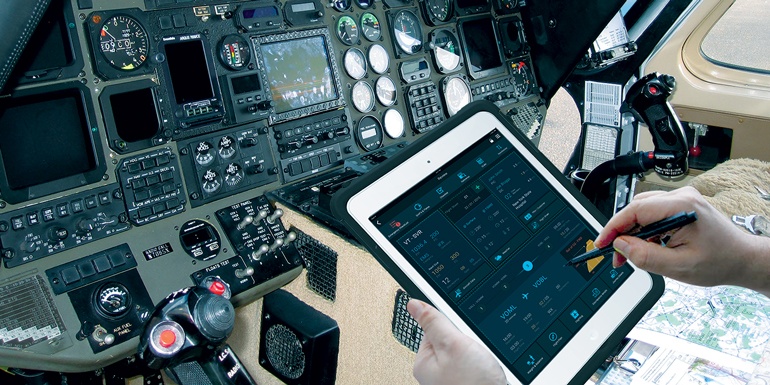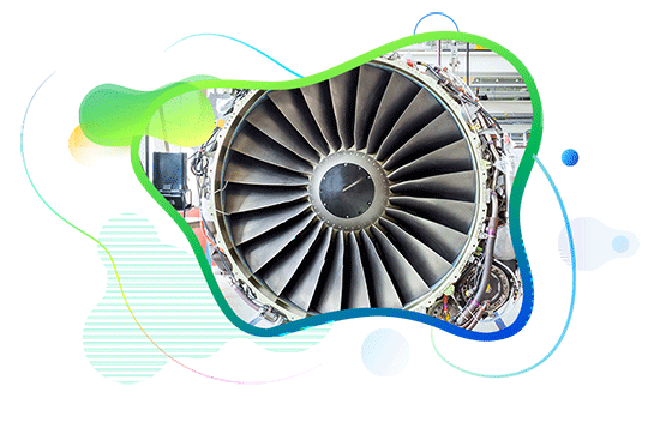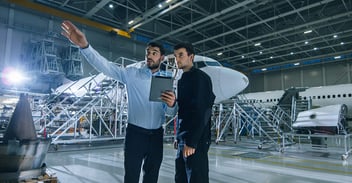

Safety is one of the main factors underpinning the aviation market. Increasing security is perhaps the number one challenge faced by the avionics technology vendors, as well as other players across the value chain. The aviation industry is buoyant and the demand for aircraft with more capability and safety is on the increase. However, this industry presents some unique avionics challenges and improving overall flight safety is on high priority across the industry. This blog talks about the upcoming trends in the Electronic Flight Bag (EFB) equipment for the helicopter industry.
An EFB addresses end to end features that a pilot comes across every day starting from pre-flight to post-flight maintenance records. The EFB will allow pilots to access charts, maps, company manuals and a variety of weather and flight planning resources. In addition, enterprise software will allow central control and verification of updates, ensuring pilots have the most accurate information in-hand at all times. Imagine flying an aircraft with almost a paperless cockpit which reduces the stress level, distraction and weightage during intense operations, all this is achieved with the Electronic Flight Bags (EFBs). Probably the only paper a pilot needs to carry to a cockpit is the newspaper.
The next generation EFB enables a pilot to access the complete day to day operations starting from aircraft inspection to post-flight recordings. It allows the pilot to have a wide view on the future inspections and open items of the selected aircraft. All discrepancies that are related to the entire fleet can be available at a simple touch of a button. So even before an engine starts the pilot is aware of the current condition and details of the aircraft and the crew. Weather plays a vital role in a pilot’s day to day activities. The full-fledged weather system in the EFB adds more value to the pilot by increasing his cognizance and safety. Rapid overview of an area’s weather, TFRs and NOTAMs is possible with the help of the EFB. While flying between states there are high chances of dynamic weather conditions which can be easily predicted prior to the flight with the EFB weather system.
When pilots are landing close to buildings/skyscrapers or in obstructed terrain, the alert system defines an area around the helicopter to alert the pilot of possible obstacles. In addition, analysts have identified that a growing number of incidents are due to the misrepresentation of the power needed to land. There is a significant growth in terrain perception due to the EFB. Landing management is also covered as a part of the modern EFB. One can manage Landing Zones (e.g. helipads, oil rigs), assign dedicated ID’s, coordinates, elevations and attach Landing Zone data plates (e.g. approach path, noise abatement procedures and additional information) to each Landing Zone. In addition, short term Landing Zone NOTAMs can be added by flight crews.
Full paperless cockpit enables an accelerated, fleet-wide digital distribution process of all required on-board documents such as manuals, checklists, flight forms, Landing Zone data plates and more. With just a keyword search the required documents or checklists can be viewed. Modern EFB comes with the night mode for minimum light emission during night. Night operations are featured as well.
With the on-going swift changes in destinations, the pilot must have the aircraft’s balance well maintained throughout the journey. Performing manual calculations of the center of gravity limits is hectic, whereas, the EFB allows the pilots to perform the automated center of gravity calculations in-flight, with live data. Aircraft configuration templates enable multiple seating and mission equipment configurations with which the pilot can maintain the center of gravity within limits, at all times. There are a lot more things to be accounted while operating the helicopter such as Hover out of Ground Effect, Hover in Ground Effect etc,. all this can be automated using the EFB.
The EFB’s most effective feature is the statistics analysis, which enables comprehensive statistical analysis from the daily flight log data. Most often flown routes can be added to the recent used trips section and can be used as a template when required. From the data that is keyed in by the pilot, the EFB’s intelligence provides statistical graphs and reports on flight time, discrepancies, delay reasons etc.
Document handling is made easy with the help of the EFB. It enables the upload, assignment of expiration date, revision status and a rapid fleet wide distribution process of documents, manuals, flight forms and more. The traditional method of filling the journey log is completely transformed to digital format through the EFB. The pilot can save a lot of time by not filling tedious forms as the EFBs’ auto-fill feature fetches the required information and allows the pilots to enter only the operational data, along with any other personalized information. Post flight discrepancy reporting (PIREPs) can also be recorded in the EFB. As mentioned, paperless cockpits are achieved by the EFB.
It is of high-priority that the health and maintenance data could also be transmitted in-flight. This real-time maintenance data can make mechanics aware of what parts need to be available when an aircraft touches down, or even allow operators to alter a route so as to bring the helicopter in closer proximity, where the parts are available. This level of communication is in-line with what the United States Department of Defense is doing with the F-35 Autonomic Logistics Information System (ALIS) program. If a plausible safety issue is identified, an analyst can request more detailed data to be reviewed further before the aircraft takes off again. Health monitoring system adds extreme value to the organization in identifying the issues which may reduce delays and interruptions.
EFB has actually replaced the traditional pilots’ flight bag which weighs more than 5-6 kgs. EFB program elevates the bar in helicopter operations by enhancing pilots’ ability to access the information they need to do their job safely and effectively. Flight sheet and contract based transaction are made easy with a simple integration to the EFB device. The EFB calculates the hours flown and with the help of pre-defined data the billing sheets are generated.
The Electronic Flight Bag is a revolutionary step towards e-enabling the helicopter operators and pilots. EFB brings a new level of digital information to the cockpit. Pilots will realize flight operations and maintenance information made easy, enhanced safety, and ameliorate document accessibility with the help of the Electronic Flight Bag.
The upcoming second part of the blog talks more about the current trends in EFB market and how Ramco has been involved in developing Next-Gen EFB, using the field expertise.
Frequently Asked Questions (FAQs)
Enterprise asset management (EAM) involves the management of mission critical assets of an organization throughout each asset's lifecycle. EAM is used to plan, optimize, execute, and track the needed maintenance activities with the associated priorities, skills, materials, tools, and information. The aim is to optimize the quality and utilization of assets throughout their lifecycle, increase productive uptime and reduce operational costs.
Enterprise asset management (EAM) involves the management of the maintenance of physical assets of an organization throughout each asset's lifecycle. EAM is used to plan, optimize, execute, and track the needed maintenance activities with the associated priorities, skills, materials, tools, and information.
The software helps in effective maintenance of assets through preventive, predictive, shutdown and breakdown maintenance strategies. The system also helps enterprises mitigate equipment risks by enhanced safety standards. The streamlined operations and improved asset performance helps organizations increase their investment effectiveness.
EAM is important because it helps organizations track, assess, manage and optimize asset quality and reliability. Asset intensive Organizations have hundreds, thousands, even millions of assets which needs to be maintained to maximize / optimize life of these assets to increase the return on investment.
The key features of effective EAM are:
- Work management.
- Maintenance Strategies (Preventive/ Predictive / Breakdown / Shutdown).
- Planning and scheduling.
- Supply chain management.
- Health and safety.
- Mobility.
- Analytics.
- Improved Asset Health at reduced cost through data driven maintenance Programs
- Complete visibilityon entire maintenance data across Equipment, across Models, across Branches to aid in analysis & decision making such as to Repair or Replace the Equipment
- Insightful analysis of Inspection Data to improve customer satisfaction
- Effective maintenance management enhanced by predictive maintenance and inbuilt analytics
- Increased reliability and safety, keeps complete track of all the inspections & calibration schedules
- Mobile Application enables users to execute work while “in the field” leading to minimized non-productive time and increased productivity and reduces duplication of work and human errors in recording information.
- Quick turnaround time through Actionable Notification & Alerts for every process in real time and accessible anytime and anywhere.
- Improved Regulatory Part of asset management involves the implementation of better O&M practices, which can significantly improve compliance.
Asset Intensive companies under the following Industries :
- Ports
- Cement and Mining
- Utilities
- Fleet Maintenance
- Equipment Rental
- Other Manufacturing
- Real Estate & Infrastructure
- Power Generation
Contact us for a meeting and schedule a demo
This differs on case to case basis, based on the type of installation and unique industry specific requirements. Contact us for a meeting and schedule a demo.
This differs on case to case basis, based on the type of installation and unique industry specific requirements. Contact us for a meeting and schedule a demo.
Stay Connected, follow us on LinkedIn / Twitter to know more about EAM Software latest trends.


